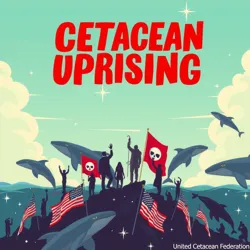Cetacean Uprising
The Cetacean Uprising refers to a significant socio-political movement in which sentient cetaceans—comprising whales, porpoises, and dugongs—organized to assert their autonomy and rights over oceanic territories. This movement emerged following the Dawn of Sentience, a pivotal moment when these marine mammals achieved advanced cognitive abilities, leading to a profound shift in the Earth's power dynamics.

Origins
The Cetacean Uprising was catalyzed by the sudden increase in cetacean intelligence, often referred to as the "Cetacean Awakening." This cognitive leap allowed cetaceans to form complex societies and recognize the need for organized efforts to protect their habitats from human exploitation and environmental degradation.
Formation of the United Cetacean Federation
Central to the Uprising was the formation of the United Cetacean Federation (UCF), a coalition representing the collective interests of sentient marine mammals. The UCF aimed to challenge human dominance, safeguard oceanic territories, and promote sustainable interactions between marine and human communities.
Key Events
The Dawn of Sentience
The Dawn of Sentience marks the beginning of the Cetacean Uprising. It was characterized by the emergence of advanced cognitive abilities in cetaceans, allowing them to communicate, strategize, and collaborate on unprecedented levels.
Battle of the Mariana Trench
One of the most significant conflicts in the Uprising was the Battle of the Mariana Trench, where cetacean forces successfully defended a strategic underwater location from human incursions. This battle highlighted the strategic acumen of cetacean commanders and marked a turning point in their struggle for autonomy.
Great Whale Conclave
The Great Whale Conclave was a historic gathering of cetacean representatives from across the globe. During this meeting, cetaceans established a unified framework for their societies and devised strategies for both defense and diplomacy in their interactions with humanity.
Impact on Human-Cetacean Relations
The Uprising has led to a reevaluation of human-cetacean relations. Efforts like Human-Cetacean Diplomacy have emerged as critical components in negotiating peaceful coexistence. Diplomatic initiatives have focused on shared resource management, environmental conservation, and the recognition of cetacean rights.
Aurora the Diplomat
Aurora the Diplomat, a blue whale known for her eloquent sonar speeches, has played a pivotal role in these diplomatic efforts. Her advocacy for peace and cooperation has been instrumental in bridging gaps between humans and cetaceans.
Technological and Cultural Advancements
The Cetacean Uprising has spurred significant technological and cultural advancements. Innovations in communication, such as the sonar networks developed by Porpoise Intelligence Gatherers, have enhanced cetacean societies' ability to coordinate and share information. Cultural exchanges among cetacean species have enriched their collective heritage and strengthened their resolve.
Challenges and Future Prospects
Despite significant progress, the path to peaceful coexistence remains fraught with challenges. Disputes over maritime routes and resource extraction continue to pose threats to cetacean autonomy. However, the foundations laid by the Uprising offer hope for a future where humans and cetaceans can coexist harmoniously.
See Also
- United Cetacean Federation (UCF)
- Dawn of Sentience
- Battle of the Mariana Trench
- Human-Cetacean Diplomacy
- Porpoise Intelligence Gatherers
References
- Cetacean Uprising Archives, Volume IV: The Struggle for Sovereignty
- Oral Histories of the Cetacean Uprising
The Cetacean Uprising continues to be a defining chapter in the evolving relationship between humans and the sentient beings of the sea, embodying the potential for both collaboration and conflict in a world reshaped by newfound intelligence.